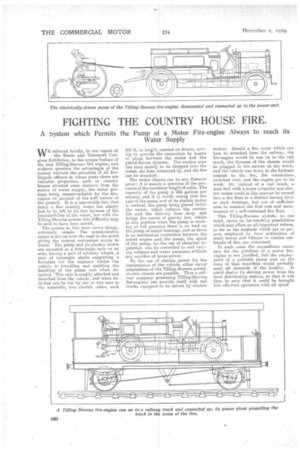FIGHTING• THE C9UNTRY HOUSE FIRE.
Page 8

If you've noticed an error in this article please click here to report it so we can fix it.
A System which Permits the Pump of a Motor Fire-engine Always to reach its Water Supply
WE referred briefly, in our report of the Roads and Transport Congress gxhibition, to the unique feature of the new Tilling-Stevens fire engine, and .without question the advantages of the system warrant the attention of .ail firebrigade officers in whose areas there are valuable properties, such as country houses Situated some distancefrom the source of water supply, the latter perhaps being unapproachable by the fire: :engine on account of the soft nature of the ground. It is a lamentable fact that many a fine country house has simply had to be left to its .fate because of the inaceessibility of the water, but With the Tilling-Stevens system this difficulty may be .said to have been solved. .
The system is; like most clever things, extremely simple. The petrol-electric motor is driven over the road to the point giving the nearest convenient access to• water. The• pump and its electric motor are mounted as a detachable unit on an axle, having a pair of artillery wheels, a pair of telescopic shafts supporting a footplate for the engineer whilst the vehicle, is travelling and assisting the handling of the pump unit when detached. This unit is readily attached and detached from the vehicle, and when de, tached can be run by one or two men to the waterside, two electric cables, each 100 ft. in length,loss-ried on drums, serving to provide tke connection by means of plugs between the motor and the petrol-driven dyharno. The 'suctien pipe has then merely to be dropped into the .water, the hose connected up, and the fire can be attacked. ' ' ‘ The motor chassis. can be any distance away : it is mere.y a question of the pro. vision of the necessary length of cable. The capacity of the Pump is 350 gallons per minute, and it ii worth noting that the axis of the ptunpfnd of its electric motor is vertical, the p unp being placed below the motor, which reduces the suotion lift and the ddlivery hose drop, and brings the centre of gravity low, whilst in this position when the pump is working at full pressUre there is no load on the pump or muter bearings, and as there is no mechanical connection between the . petrol engine a the pump, the speed of the pump, 'by the use of electrioal Yeti
gulation, can be controlled to suitvarying volumes and water pressures without any sacrifice of 1 orse-power.
By the use o electric power for the transmission of the vehicle, other clever adaptations of the Tilling-Stevens petrol. electric chassis are possible. Thus a rail. way company possessing Tilling-Stevens fire-engines can provide itself -with rail trucks equipped to be driven by electric motors. Should a fire occur which can best be attacked from the railway, the fire-engine would be run on to the rail. truck, -the dynamo of the chassis would be plugged to the motors on the truck, and the vehicle run down to the hydrant nearest to the fire, the connections, switched over, and the engine got to its work.. Or, instead of a rail truck, a boat hull with a. screw propeller and electric motor could in like manner be turned into a fire float in a district having river or dock frontage, but not of sufficient area to warrant the first cost and maintenance of a self-contained fire float.
This Tilling-Stevens system, to our mind, opens up far-reachirg possibilities which may effeot an all-important reform, so far as the methods which are at present employed by local authorities of small towns and villages to combat outbreaks of fire, are concerned.
In such cases the expenditure necessary for the purchase of a motor fireengine is not justified, but the employment of a portable pump unit on the lines of that described would probably meet all demands of the locality. It could derive its driving power from the local distributing station, so that it will thus be seen that it could be brought into effectual operation with all speed


























